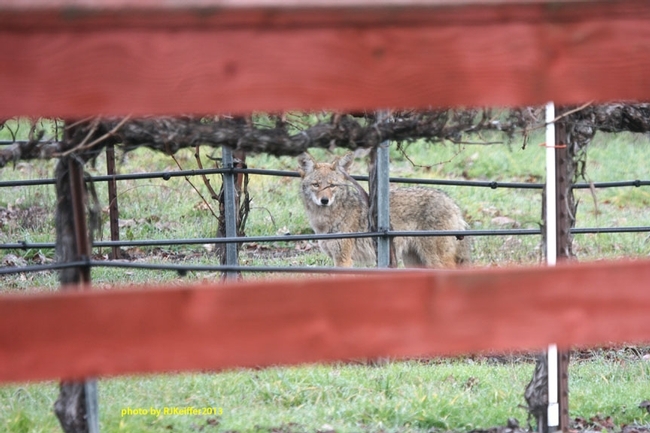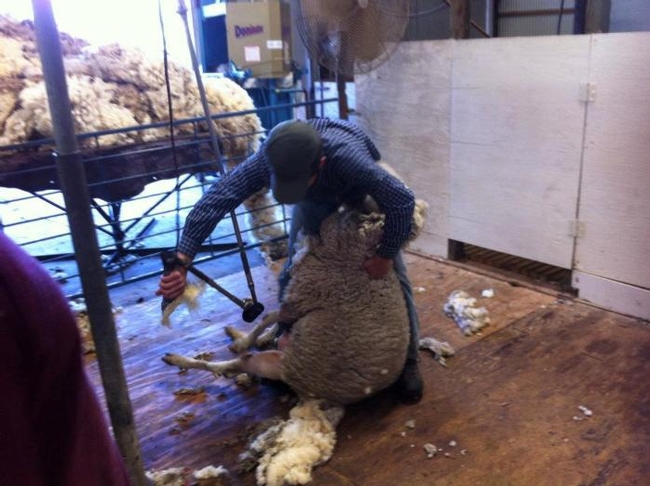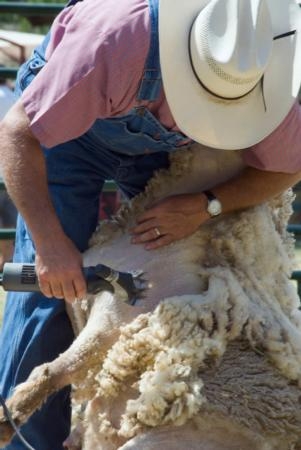Posts Tagged: sheep
'Wild and wooly' sheep shearing class held at Hopland
Many sheep shearing students said the process was "the hardest thing they have ever done," reported Glenda Anderson in the Santa Rosa Press Democrat. The newspaper ran a lengthy feature and a photo gallery of the annual sheep shearing school held at the UC Hopland Research and Extension Center this week.
Reporter Justine Frederiksen of the Ukiah Daily Journal also reported on the sold-out sheep shearing and wool classing training at the 5,300-acre Mendocino County research center.
“And 60 percent of these people had never even touched a sheep before,” said John Harper, UCCE advisor and shearing school leader. Nearly all the students were women and included an artist from San Francisco, a retired fire chief, a UC Davis graduate student, and a woman who was learning to shear ahead of travels to New Zealand “because I think it will be a good skill to have for work, in case I want to stay for a couple of months.”
“One of the things new students have the most trouble with is what we call ‘tipping' the sheep, or flipping them over,” Harper said. He explained that, to get the sheep into the ideal starting position, you need to push its back legs down with one hand and tuck its head in with the other, twisting the animal into a sitting position with all four legs dangling.
UC Hopland REC sheep shearing students are part of a new wave of sheep shearers and wool enthusiasts industry officials hope will reverse decades of disinterest and decline. The shearing classes were booked well ahead of time, said Hannah Bird, a community educator at the research station. Many students are seeking a break from city life or jobs tying them to a desk.
Wrote reporter Glenda Anderson, shearing sheep is sweaty, back-straining work that earns just $2 to $5 per sheep. But an expert sheep shearer taking part in the program said sheep shearing for a living has its benefits.
“It's a lifestyle thing. I could work six months a year and travel around the world,” paying for the travel by working here and there, he said.
Mendocino County no longer to contract with USDA Wildlife Services
Mendocino County supervisors decided to sever ties with the USDA's division of Wildlife Services, reported Peter Fimrite in the San Francisco Chronicle. The decision was made after environmental groups said the agency was indiscriminately killing predators, such as mountain lions and coyotes, because they are a threat to livestock.
The article featured a gallery of 10 artful photos taken at the UC Hopland Research and Extension Center, which maintains a research sheep flock of 500 breeding ewes. Record-keeping of sheep losses to predators began at Hopland in 1973. Coyotes are the most serious predator problem.
Hopland staff use a variety of non-lethal and preventative methods to protect sheep from predators, such as fencing, mob grazing and frequent pasture rotation and guard dogs, according to Kim Rodrigues, the director of the research and extension facility. Currently there are five guard dogs at the center. The guard dogs bond with sheep and protect them primarily by barking and other aggressive behaviors when strangers or predators are near the sheep flock.
Non-lethal predator wildlife control helps keep livestock safe
Five guard dogs are part of the team protecting sheep at a UC Agriculture and Natural Resources (UC ANR) research center in Mendocino County. The director of the UC Hopland Research and Extension Center (HREC) Kim Rodriguez is optimistic the dogs and other non-lethal wildlife control efforts being used at the station will allow peaceful grazing animals to share land with natural predators, reported Sarah Reith in the Ukiah Daily Journal.
Rodrigues initiated a new standard operating procedure (SOP) at Hopland early this year for predator animal control. The policy involves guard dogs, improved fencing and pasture management to protect sheep from coyotes, rather than shooting the predators. Jim Lewers, senior animal technician at HREC, said the "losses have declined" since the new policy was put in place.
Hannah Bird, HREC community educator, said 10 sheep at the center were killed by coyotes in 2015, while 43 were killed in 2014.
Rodrigues told the reporter that it is hard to attribute declines in animal deaths to a single strategy. She hopes to eventually make Hopland a hub for research and information sharing with local landowners on wildlife control.
That effort begins next week. On Dec. 1 and 2, HREC will offer two separate workshops on wildlife management. The first day will include representatives from USDA Wildlife Services, the California Dept. of Fish and Wildlife, and Defenders of Wildlife. On the second day, local ranchers and UC ANR representatives will speak about their chosen methods of wildlife management. Registration is $30 per day. Registration for the two days is separate, and the deadline is Saturday, Nov. 28.
Click here to register for the Dec. 1 workshop.
Click here to register for the Dec. 2 workshop.
Software developer quits job to shear sheep
"This year, I was on a ranch almost every weekend from January through June," Wilke said. "I got pretty burnt out."
With skills honed in three five-day sessions of training at the UC Agriculture and Natural Resources facility in Hopland, she has found she can earn between $50 and $100 per hour shearing sheep.
John Harper, UC ANR Cooperative Extension advisor in Mendocino County, has hosted the sheep shearing school for 20 years and has 40 years experience with sheep shearing.
"It is the longest running shearing school in California and I believe it's currently the only one," Harper said.
The training school started with instructors imported from New Zealand. When the cost of travel became prohibitive, Harper brought in Mike McWilliams from Oregon. Later Gary Vorderbruggen, who trained under McWilliams, became the chief instructor.
The five-day course will be offered again in 2016 with classroom instruction, demonstrations and hands-on experience. Beginning and experienced shearers have the opportunity for one-on-one training. Class dates have not yet been decided. Registration information will be posted on the Sheep Shearing School webpage.
View a PDF version of the Sheep Magazine article by clicking the link below.
Sheep Magazine article
UC ANR workshop inspires economic development
UC Agriculture and Natural Resources (UC ANR) is helping get a new industry off the ground in Mendocino County, reported Justine Frederiksen in the Ukiah Daily Journal.
The UC Hopland Research and Extension Center, a UC ANR facility, hosts an annual Sheep Shearing School, thought to be the only one in California. The students take a five-day hands-on course to learn how to maintain a quality wool clip and minimize stress to the sheep.
"It's like learning to square dance," said instructor Gary Vorderbruggen. "Except you're learning to dance with an unwilling partner."
UC ANR Cooperative Extension natural resources advisor John Harper facilitates the school in Mendocino County.
"I always say, you'll never be unemployed if you learn how to shear," Harper said. "There's never enough shearers."
One local resident who attended Sheep Shearing School twice, Matthew Gilbert, was inspired to open a local wool processing enterprise.
"It's the perfect fit for this county, because it will provide jobs for this rural economy," Harper said.
Many wineries are using sheep to clip cover crops because the sheep can't get up on their hind legs like goats to reach the foliage. Even as more sheep are working local vineyards, "we're losing the infrastructure to support the (sheep) industry," Harper said.
Last week, the Ukiah Planning Commission unanimously approved permits for Gilbert to operate a wool mill and food truck on his property, said another article in the Ukiah Daily Journal. The food truck will help supplement the family's income for the first couple of years until the mill becomes established.
Further enhancing local interest in the Mendocino County sheep industry, the Hopland REC hosts a Barn to Yarn event from 10 a.m. to 2 p.m. May 23. Visitors will see shearing, spinning and weaving demonstrations and learn how to class wool and dye it using Kool-Aid. Admission is $5 per person, and children under 12 are free. The Hopland REC is at 4070 University Rd., Hopland. For more information, call Hannah Bird at (707) 744-1424, ext. 105.





